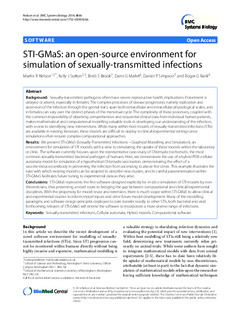| dc.description.abstract | Background: Sexually-transmitted pathogens often have severe reproductive health implications if treatment is
delayed or absent, especially in females. The complex processes of disease progression, namely replication and
ascension of the infection through the genital tract, span both extracellular and intracellular physiological scales, and
in females can vary over the distinct phases of the menstrual cycle. The complexity of these processes, coupled with
the common impossibility of obtaining comprehensive and sequential clinical data from individual human patients,
makes mathematical and computational modelling valuable tools in developing our understanding of the infection,
with a view to identifying new interventions. While many within-host models of sexually-transmitted infections (STIs)
are available in existing literature, these models are difficult to deploy in clinical/experimental settings since
simulations often require complex computational approaches.
Results: We present STI-GMaS (Sexually-Transmitted Infections – Graphical Modelling and Simulation), an
environment for simulation of STI models, with a view to stimulating the uptake of these models within the laboratory
or clinic. The software currently focuses upon the representative case-study of Chlamydia trachomatis, themost
common sexually-transmitted bacterial pathogen of humans. Here, we demonstrate the use of a hybrid PDE–cellular
automata model for simulation of a hypothetical Chlamydia vaccination, demonstrating the effect of a
vaccine-induced antibody in preventing the infection from ascending to above the cervix. This example illustrates the
ease with which existing models can be adapted to describe new studies, and its careful parameterisation within
STI-GMaS facilitates future tuning to experimental data as they arise.
Conclusions: STI-GMaS represents the first software designed explicitly for in-silico simulation of STI models by nontheoreticians,
thus presenting a novel route to bridging the gap between computational and clinical/experimental
disciplines. With the propensity for model reuse and extension, there is much scope within STI-GMaS to allow clinical
and experimental studies to inform model inputs and drive future model development. Many of the modelling
paradigms and software design principles deployed to date transfer readily to other STIs, both bacterial and viral;
forthcoming releases of STI-GMaS will extend the software to incorporate a more diverse range of infections. | nb_NO |
| dc.description.localcode | © 2014 Nelson et al.; licensee BioMed Central Ltd. This is an Open Access article distributed under the terms of the Creative Commons Attribution License (http://creativecommons.org/licenses/by/2.0), which permits unrestricted use, distribution, and reproduction in any medium, provided the original work is properly credited. The Creative Commons Public Domain Dedication waiver (http://creativecommons.org/publicdomain/zero/1.0/) applies to the data made available in this article, unless otherwise stated. | nb_NO |
